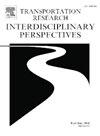Design and evaluation of a novel curved speed hump (CSH) for Indian roads
IF 3.9
Q2 TRANSPORTATION
Transportation Research Interdisciplinary Perspectives
Pub Date : 2025-07-01
DOI:10.1016/j.trip.2025.101527
引用次数: 0
Abstract
Traffic calming measures are crucial for sustainable traffic management. Globally, vertical and horizontal techniques, such as speed humps, speed cushions, roundabouts and chicanes are used to reduce vehicle speeds and enhance road safety. While effective in achieving these goals, traditional traffic calming devices can have negative impacts on vehicles and the environment. To address these issues, a Curved Speed Hump (CSH) is introduced as a novel traffic calming solution specifically designed for Indian road conditions. CSH consists of a main speed hump, which is raised and curved structure positioned within a lane and complemented by an additional speed hump, adjacent to it. Motorists have the option to navigate along the curved trajectory, effectively moderating their speeds while mitigating the drawbacks typically associated with conventional vertical measures. This study outlines the CSHs objectives and geometric configuration. Through series of interconnected experimental field trials, including preliminary testing, driver perception studies, and real-world deployment. The final optimized design parameters obtained from the studies, features a radius of curvature (R) of the main CSH of 15 m, with lengths (L) of main CSH at 5 m and 6 m. Objective speed (Vb) for these parameters range from 20 km/h to 25 km/h and 30 km/h to 35 km/h, respectively. Driver perception studies for these parameters resulted in positive perceptions of comfort, safety, and speed reduction. Additionally, field implementation showed that the CSH outperformed traditional speed humps when comparisons were made to validate the CSH.
印度道路新型弯曲速度驼峰(CSH)设计与评价
交通平静化措施对可持续交通管理至关重要。在全球范围内,垂直和水平技术,如减速带、减速垫、环形交叉路口和减速弯被用于降低车辆速度和加强道路安全。虽然能有效实现这些目标,但传统的交通平静装置会对车辆和环境产生负面影响。为了解决这些问题,该公司推出了弯曲速度驼峰(CSH),这是一种专门针对印度路况设计的新型交通平静解决方案。高速公路由一个主速度驼峰组成,它是一个凸起和弯曲的结构,位于车道内,并与它相邻的一个额外的速度驼峰相辅相成。司机可以选择沿着弯曲的轨迹行驶,有效地减缓了他们的速度,同时减轻了传统垂直测量的缺点。本研究概述了CSHs的目标和几何结构。通过一系列相互关联的现场试验,包括初步测试、驾驶员感知研究和实际部署。研究得到的最终优化设计参数为:主水轮机曲率半径R为15 m,主水轮机长度L分别为5 m和6 m。这些参数的目标速度(Vb)分别为20公里/小时至25公里/小时和30公里/小时至35公里/小时。驾驶员对这些参数的感知研究产生了对舒适性、安全性和速度降低的积极感知。此外,现场实施表明,当进行比较以验证CSH时,CSH的性能优于传统的减速带。
本文章由计算机程序翻译,如有差异,请以英文原文为准。
求助全文
约1分钟内获得全文
求助全文
来源期刊

Transportation Research Interdisciplinary Perspectives
Engineering-Automotive Engineering
CiteScore
12.90
自引率
0.00%
发文量
185
审稿时长
22 weeks
 求助内容:
求助内容: 应助结果提醒方式:
应助结果提醒方式:


